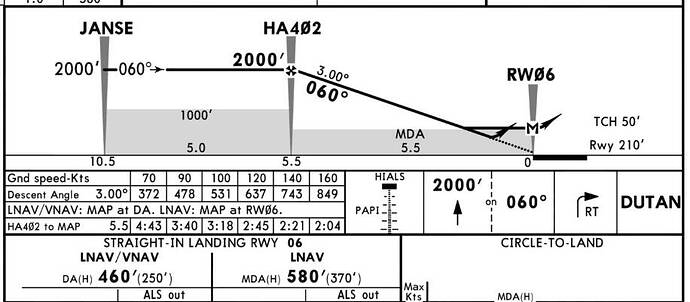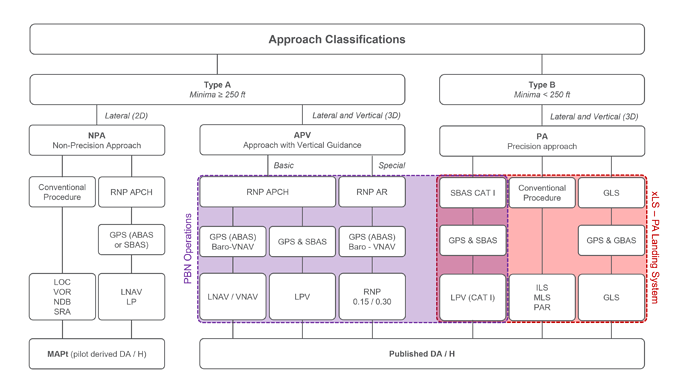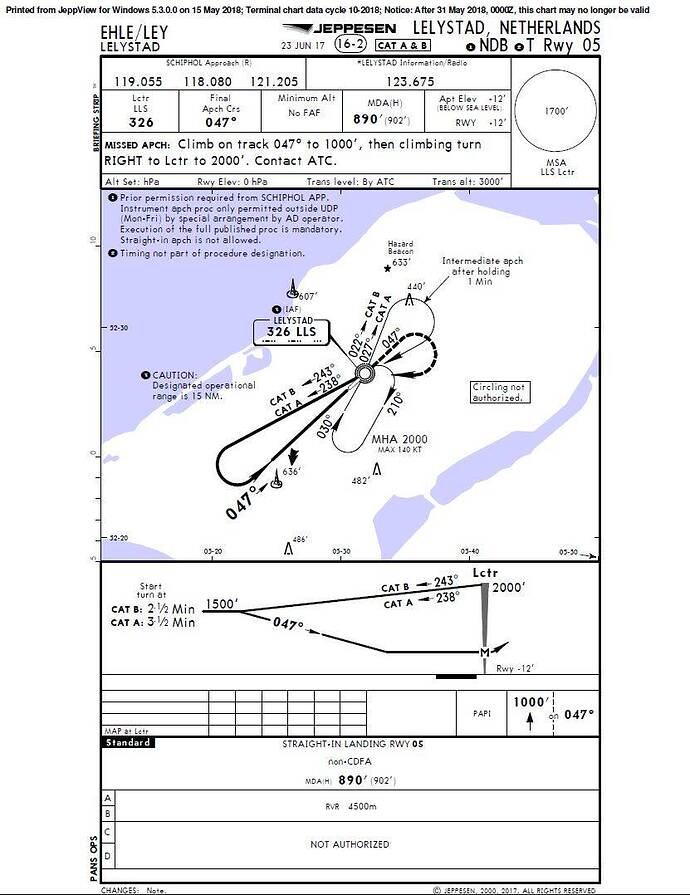Definitions
First of all some definitions:
ABAS = Aircraft Based Augmentation System
APV = Approach with Vertical Guidance
BRNAV = Basic RNAV (RNAV 5)
CDFA = Continuous Descent Final Approach
GBAS = Ground Based Augmentation System
GLS = GPS Landing System
GPS = Global Positioning System
ILS = Instrument Landing System
LNAV = Lateral Navigation
LOC = Localizer
LP = Localizer Performance
LPV = Localizer Performance with Vertical Guidance
MDA = Minimum Descent Altitude
MLS = Microwave Landing System
NDB = Non-directional Beacon
NPA = Non-Precision Approach
SBAS = Satellite Based Augmentation System
SRA = Surveillance Radar Approach
PA = Precision Approach
RNAV = Area Navigation
RNP = Required Navigation Performance
VNAV = Vertical Navigation
VOR = VHF Omnidirectional Radio Range
ICAO Approach Classifications
In the basis ICAO has prescribed 2 types of approaches, one type with minima of 250ft or higher (further divided into Non-Precision Approach (NPA) and Approach with Vertical Guidance (APV)) and approaches with a minima below 250 ft (Precision Approaches ¶). In the diagram below you can see the different approach categories, conventional procedures, RNP approach procedures, RNP AR (approval required), and GLS (GPS Landing System).
RNP Approaches
All approaches are labelled RNP nowadays, the only real difference between RNP and RNAV is that for RNP there must be a alerting system available, warning the pilots in case of loss of RAIM (Receiver Autonomous Integrity Monitoring), loss of position (FMS in dead-reckoning mode) or Actual Navigation Performance (ANP) exceeding the Required Navigation Performance (RNP). Otherwise the meaning is the same, RNP 5 or RNAV 5 (also called BRNAV) means that the Total System Error (TSE) should be less than the RNP number (example RNAV / RNP 5 = 5 nm) for 95% of the flight time. Usually en-route = RNP 5, terminal operations = RNP 1, approach = RNP 0.3.
Minima
Be aware that the DA/H on a LNAV or LP approach is actually a MDA/H, Jeppesen publishes these minima as DA/H (at least in Europe) but those have no margin built in for altitude loss in case of go-around so you have to make the decision above this DA/H, we add +30 ft for turboprops in our fleet and +50 ft for jets. For bigger aircraft its probably more but its up to the operator to establish those. The reason for this has to do with history. Non-precision approaches are conventionally flown as non-CDFA (Continuous Descent Final Approach) meaning that an aircraft would descent to the MDA/H, level-off, fly level to the missed-approach point (MAPt) and then decide whether to land or go-around.
CDFA
Nowadays most NPA approaches are flown as CDFA approaches but the requirements for minima on those approaches have not changed. No matter what the chart manufacturer calls those, they are in fact MDA/H, in other words you are not allowed to descent below that altitude so you need to make the decision before passing the MDA/H. You can create a pilot derived DA/H by adding a margin for decision making and altitude loss in case of go-around (the +30/50 ft addition as described above).
Here is an example of an old non-CDFA approach. This is how non-precision approaches were conventionally flown, you can imagine that this isn’t the preferred method of flying an approach with a Boeing 747, flying level at a few hundred feet with flaps and gear out… That is why this approach is not authorized for Cat C & D. Also note that the missed-approach point (MAPt) is passed the runway! In other words, the aircraft is in no position to land when becoming visual at the MAPt.



